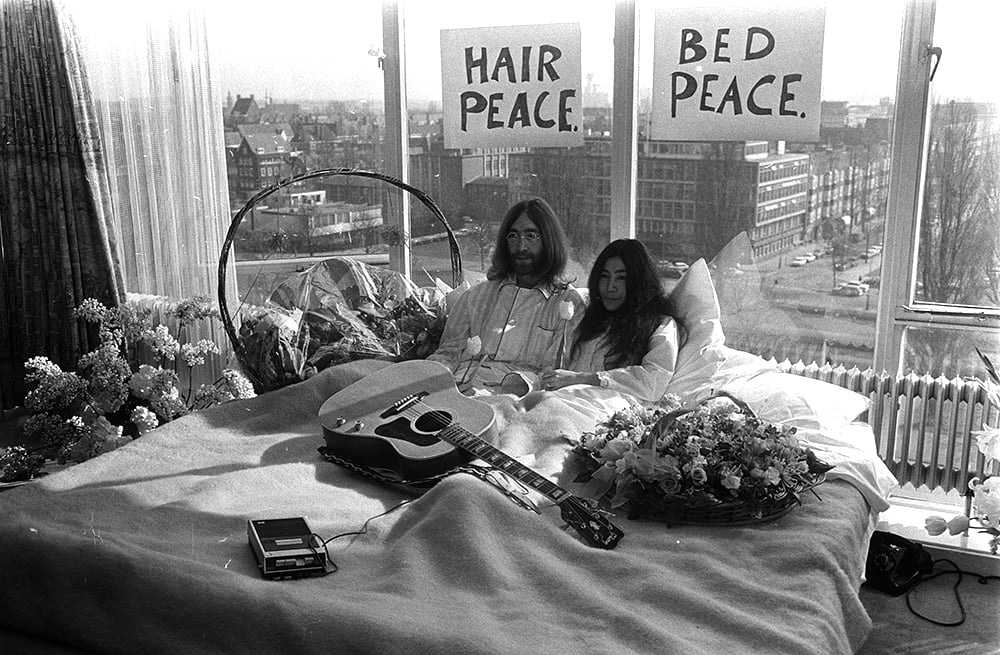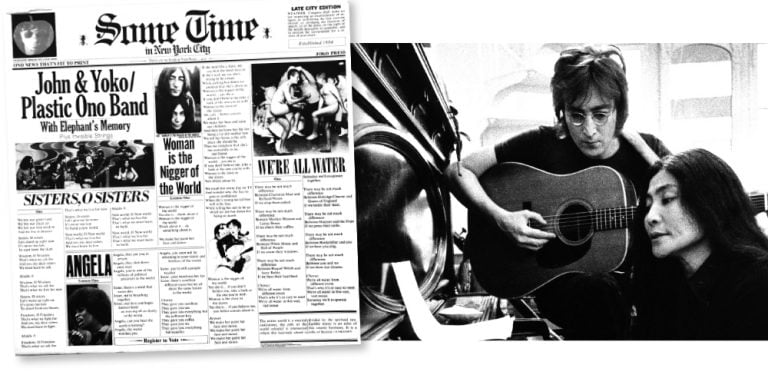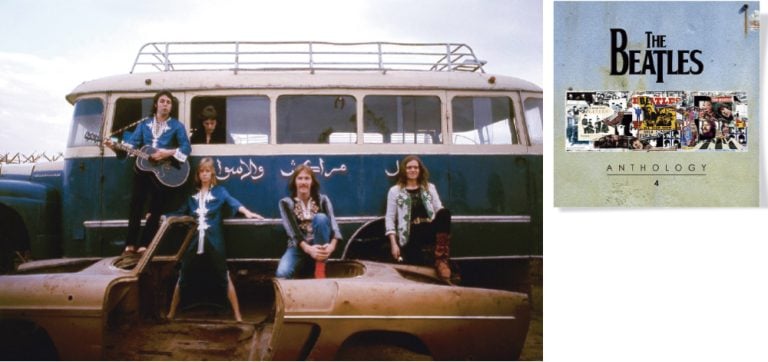The activist Lennon

Former Beatle John Lennon's period of greatest political activism is the focus of the Power to the People project, which has arrived in stores and on streaming platforms as part of the celebrations for what would have been his 85th birthday. The release is the first in a series of new releases that will emerge from the Beatles' inexhaustible archive before Christmas (see text on page 50).
In a box set that includes nine CDs, three Blu-rays, a book, and memorabilia including a poster, postcards, stickers, and replica tickets, Power to the People chronicles the period of 1971 and 1972, when Lennon and Yoko Ono flirted with the new American radical left. Moving from London to New York, seeking to escape the pressures of the Beatles' breakup, the couple left behind their utopian dream of Imagine and fully embraced the counterculture.
Radical activists such as John Sinclair, Jerry Rubin, Abbie Hoffman, the Black Panthers, and Angela Davis became part of the couple's inner circle, attending marches, demonstrations, and benefit concerts.
The duo's 1972 album, "Some Time in New York City," the foundation of "Power to the People," addressed themes such as the pursuit of peace, social and racial justice, state oppression against the left, the United Kingdom against Northern Ireland, and society against women. Now, it is presented in a "reimagined" form, as the cover text states—which can also be understood as a euphemism for self-censorship.
The project stands out for bringing together, in one place, all the material, almost all of it unpublished, from a specific period of the couple's life.
On the original album, the cover art mimicked a newspaper, with song lyrics replacing news stories and unusual and controversial illustrations. The lyrics to "We're All Water," for example, sung by Yoko, asserted that people are the same everywhere, despite apparent differences, and were illustrated by a montage showing then-US and Chinese presidents Richard Nixon and Mao Zedong dancing naked together.
Much greater controversy was provoked by the album's lead song, "Woman Is the Nigger of the World," which used the word "nigger," highly offensive to black people, to describe female oppression.
Coined by Yoko in an interview, the phrase made the headline of Nova magazine in March 1969. In 1972, Lennon used it as the title of a controversial song comparing racial oppression to gender oppression. Radio stations didn't play it, Apple Records refused to promote it in the UK, and the song and accompanying album received little attention.
On the box, however, while the photo of Nixon and Mao appears as a harmless sticker, Woman Is the Nigger of the World has been completely removed from the 123-track set, 90 of which are previously unreleased. This decision has caused astonishment among fans and critics alike.
Sean Ono Lennon, John and Yoko's son and the project supervisor, said the exclusion isn't censorship, but a cultural reflection of today's world, which doesn't tolerate the use of the word with racist connotations. Sean acknowledges that his parents' use of the term is significant and justifiable, but says his opinion doesn't reflect the general sentiment of society.
 Memorabilia. On the left, the album cover that serves as the foundation for the new release and the Lennons recording the concerts known as One to One, made in 1972 – Image: Imagine Peace/Yoko Ono
Memorabilia. On the left, the album cover that serves as the foundation for the new release and the Lennons recording the concerts known as One to One, made in 1972 – Image: Imagine Peace/Yoko Ono
In verses like "We say she should just stay at home/ and then we complain she's too uninteresting to be our friend," or "If she doesn't do what we want/ we say she doesn't love us," Lennon gave visibility to the oppression suffered by women in marriage as well.
The exclusion of a musically powerful song simply because of the use of a single word raised some questions. Wouldn't it be better to leave the decision to listen or not to the consumer? Or would it be better to keep the song, explaining its origin and implications in notes?
In 2018, at the Double Fantasy exhibition held at the Museum of Liverpool, which focused on the work of the Ono-Lennon couple, a section was dedicated to the song "Woman Is the Nigger of the World," presented in context, and it caused no major stir. The absence of the track, however, doesn't detract from the project's brilliance.
One of the box's most valuable aspects is the remixing of the tracks, which made some songs more cohesive and rhythmically stronger. "John Sinclair," about the activist's arrest, and "Sunday Bloody Sunday," about an attack in Ireland, were lengthened. Angela's harmonies are more pronounced.
The overall sound is cleaner, and the instruments are more defined—some have gained prominence, while others have faded, such as the saxophone at the beginning of Sunday Bloody Sunday. With the new title "New York City," the current remix stripped away the overproduction of the original album, leaving the sound cleaner and more understated.
The two concerts held on August 30, 1972, to benefit an organization supporting the education of children with learning disabilities are featured on three CDs. Known as the One to One concerts, they are the subject of a documentary released in IMAX theaters in the US and Europe earlier this year.
The project has been criticized for cutting a song that uses the word nigger.
Although part of the itinerary for these shows, "Woman is the Nigger of the World" was also cut from the live versions. The other CDs record concerts held to benefit UNICEF, the release of John Sinclair, and to raise funds for the families of prisoners killed in the December 1971 Attica State Penitentiary uprising, among others.
Also included are historical recordings of Lennon singing rock classics made famous by Elvis Presley and Fats Domino.
Despite not being included on the box set, the track hasn't been removed from streaming services. It remains available to listen to on its original album, "Some Time in New York City," which, according to critic Andrew Dixon, is expected to be reissued next year in Japan.
Power to the People, besides revealing more details about the political nature of Lennon's work, ends up exposing his inspirations and the evolution of his work. Often, the behind-the-scenes of an album produces works as captivating as what is revealed to us. •
…And the chest continues to be opened and rummaged throughIn November, two other releases fuel Beatlemania: the fourth volume of the Anthology series and Wings, featuring hits from Paul McCartney's second band.
 Inexhaustible. The band Wings (left) existed between 1972 and 1979 and featured Linda McCartney. Anthology 4 is the least exciting of the new releases – Image: Social Media/Paul McCartney and Universal Music
Inexhaustible. The band Wings (left) existed between 1972 and 1979 and featured Linda McCartney. Anthology 4 is the least exciting of the new releases – Image: Social Media/Paul McCartney and Universal Music
Starting in 1966, when they decided to stop touring, the Beatles spent thousands of hours in the studio. Sometimes, they recorded more than 40 takes (versions) of a song until they reached the final version.
Although, in recent years, the band's albums have been re-released in deluxe versions, featuring the original album plus demo and alternative versions, there is still a lot of unreleased material, including expectations of new songs – that is, not just different versions.
It's known, for example, that there's a song called Carnival of Light, which no one has ever heard, but which was recorded in 1967, at the same session as Penny Lane. In the case of John Lennon, in particular, there are so many takes that some box sets include a CD called Evolution, which covers everything from the first demo to the final version, detailing the song's construction.
For these and other reasons, the adjective "inexhaustible" is commonly associated with the English band's collection. And this holiday season, in the wake of Power to the People, there's more on the way.
Another, less exciting release, is the fourth volume in the Anthology series, which brings together new takes on well-known songs already explored in other volumes. Some versions are the same as those in deluxe box sets of albums released over the last decade. The tracks were remastered by Giles Martin, son of the band's legendary producer, George Martin, who has been working on updating the Beatles' sound.
Anthology 4, which will be released on November 21, features 36 tracks, of which only 13 are new, including an alternative version of All You Need Is Love, recorded during rehearsals for the BBC program that inaugurated global satellite broadcasts in 1967. There are also versions of songs that the three remaining Beatles recorded in the 1990s from cassette tapes left by Lennon.
Recorded with the technology available at the time, "Free as a Bird" and "Real Love" have had their sound deficiencies significantly reduced with the resources available today. Giles also remastered the three previous volumes of the Anthology, which will be available in a box set. And starting November 26th, the Anthology series, first broadcast in 1995, returns to Disney Plus in an expanded version.
The Anthology project – which involves the series and three double CD volumes – harks back to a period of resurgence of Beatlemania in the 1990s, and the official appearance of the group's alternative material for the first time.
Also in November, on the 7th, Wings will be released, a collection of hits from Paul McCartney's second band, which existed between 1972 and 1979, and had Linda McCartney and Denny Laine as main members.
With 22 million albums sold, the band released hits such as Live and Let Die, Band on the Run, My Love and Silly Love Songs, all featured on the compilation, which will be available on two CDs or three colored LPs.
Along with the albums, the book "Wings: The Story of a Band on the Run" will be released. McCartney wrote this book based on approximately 42 hours of previously unreleased interviews, chronicling the band's history from their first college gigs to their conquest of major stadiums around the world. Although sluggish and lacking in any new material, the compilation does include some gems, such as the single version of "Venus and Mars/Rock Show," quite different from the original album version, and the "BC Moon" side.
McCartney is the most reticent of the Beatles to release new material from his archives. But Wings is an interesting experiment because it captures a key phase of his career, without the interference of songs from his solo output. The project, however, lacks the rich sonic arsenal offered by Lennon's Power to the People. – EM
Published in issue no. 1384 of CartaCapital , on October 22, 2025.
This text appears in the print edition of CartaCapital under the title 'The activist Lennon'
CartaCapital




